第二语言学习策略论析
- 格式:pdf
- 大小:169.22 KB
- 文档页数:4
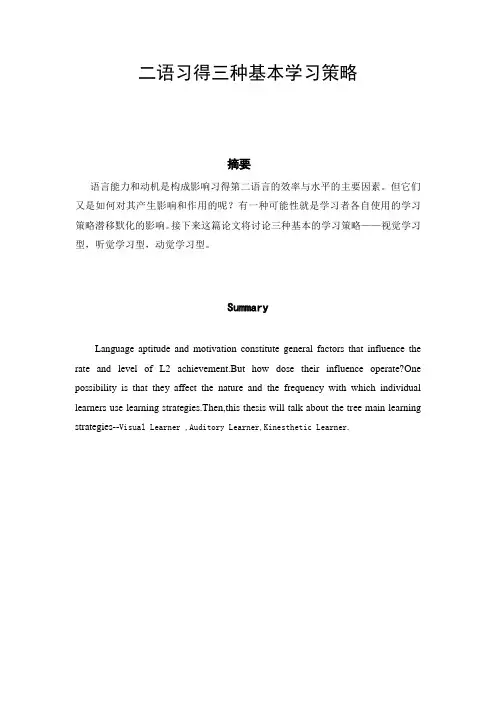
二语习得三种基本学习策略摘要语言能力和动机是构成影响习得第二语言的效率与水平的主要因素。
但它们又是如何对其产生影响和作用的呢?有一种可能性就是学习者各自使用的学习策略潜移默化的影响。
接下来这篇论文将讨论三种基本的学习策略——视觉学习型,听觉学习型,动觉学习型。
SummaryLanguage aptitude and motivation constitute general factors that influence the rate and level of L2 achievement.But how dose their influence operate?One possibility is that they affect the nature and the frequency with which individual learners use learning strategies.Then,this thesis will talk about the tree main learning strategies--Visual Learner ,Auditory Learner,Kinesthetic Learner.Tree Main Learning StrategiesLearning strategies are the particular approaches or techniques that learners employ to try to learn an L2.They can be behavioural (for example,repeating new words aloud to help you remember them)or they can be mental (for example,using the linguistic or situational context to infer the meaning of a new word).They are typically problem-oriented.That is,learners employ learning strategies when they are faced with some problem,such as how to remember a new word.Learners are generally aware of the strategies they use and,when asked,can explain what they did to try to learn something.Different kinds of learning strategies have been identified.Cognitive strategies are those that are involved in the analysis,synthesis,or transformation of learning materials. An example is recombination', which involves constructing a meaningful sentence by recombining known elements of the L2 in a new way.Metacognitive strategies are those involved in planning, monitoring,and evaluating learning.An example is 'selective attention',where the learner makes a conscious decision to attend to particular aspects of the input.Social\affective strategies concern the ways in which learners choose to interact with other speakers.An example is 'questioning for clarification'(i.e.asking for repetition,a paraphrase,or an example).There have been various attempts to discover which strategies are important for L2 acquisitions. One way is to investigate how ‘good language leaner’try to learn. This involves identifying learners who have been successful in learning an L2 and interviewing them to find out the strategies that work for them. One of the main findings of such studies is that successful language learners pay attention to both from and meaning. Good language learners are also very active, show awareness of the learning process and their own personal learning styles and, above all, are flexible and appropriate in their use of learning strategies. They seem to be especially adept at using metaconignitive strategies.Other studies have sought to relate learners’ reported use of different strategies totheir L2proficiency to try to find out which strategies are important for language development. Such studies have shown, not surprisingly, that successful learners use more strategies than unsuccessful learners. They have also shown that different strategies are related to different aspects of L2 learning. Thus, strategies that involve formal practice contribute to the development of linguistic competence whereas strategies involving functional practice aid the development of communicative skills. Successful learners may also call on different strategies at different stages of their development. However, there is the problem with how to interpret this research. Does strategy use result in learning or does learning increase learners’ability to employ more strategies? At the moment, it is not clear..An obvious question concerns how these learning strategies relate to the general kinds of psycholinguistic processes discussed in the thesis. What strategies are involved in noticing or noticing the gap, for example? Unfortunately, however, no attempt has yet been made to incorporate the various learning strategies that have been identified into a model of psycholinguistic processing. The approach to date has been simply to describe strategies and quantifying their use.The study of learning strategies is of potential value to language teachers. If those strategies that are crucial for learning can be identified, it may proved possible to train students to use them. We will examine this idea in the broader context of a discussion of the role of instruction in L2 acquisition.Following are tree basic learning strategies:Visual LearnerVisual learning is a teaching and learning style in which ideas, concepts, data and other information are associated with images and techniques.Visual learners prefer to have information presented in graphs, graphic organizers such as webs, concept maps and idea maps, plots, and illustrations such as stack plots and V enn plots, are some of the techniques used in visual learning to enhance thinking and learning skills. Visual learners are said to possess great instinctive direction, can easily visualize objects, and are excellent organizers.Although learning styles have "enormous popularity" and both children and adults express personal preferences, there is no evidence that identifying a student's learning style produces better outcomes, and there is significant evidence that the widespread "meshing hypothesis" (that a student will learn best if taught in a method deemed appropriate for the student's learning style) is invalid. Well-designed studies "flatly contradict the popular meshing hypothesis".The characteristics of the Visual learners:∙Reader/observer∙Scans everything; wants to see things, enjoys visual stimulation∙Enjoys maps, pictures, diagrams, and color∙Needs to see the teacher’s body language/facial expression to fully understand∙Not pleased with lectures∙Daydreams; a word, sound or smell causes recall and mental wandering ∙Usually takes detailed notes∙May think in pictures and learn best from visual display.∙Have a clear view of your teachers when they are speaking so you can see their body language and facial expression∙Use color to highlight important points in text∙Illustrate your ideas as a picture and use mind maps∙Use multi-media such as computers or videos.∙Study in a quiet place away from verbal disturbances∙Visualize information as a picture to aid learning∙Make charts, graphs and tables in your notes.∙Participate actively in class—this will keep you involved and alert∙When memorizing material, write it over and over∙Keep pencil and paper handy so you can write down good ideas.Auditory LearnerAuditory learners are those who learn best through hearing things.They may struggle to understand a chapter they've read, but then experience a full understanding as they listen to the class lecture.. An auditory learner may benefit by using the speech recognition tool available on many PCs.Auditory learners may have a knack for ascertaining the true meaning of someone's words by listening to audible signals like changes in tone. When memorizing a phone number, an auditory learner will say it out loud and then remember how it sounded to recall it.Look over these traits to see if they sound familiar to you. Y ou may be an auditory learner if you are someone who:∙Likes to read to self out loud.∙Is not afraid to speak in class.∙Likes oral reports.∙Is good at explaining.∙Remembers names.∙Notices sound effects in movies.∙Enjoys music.∙Is good at grammar and foreign language.∙Reads slowly.∙Follows spoken directions well.∙Can't keep quiet for long periods.∙Enjoys acting, being on stage.∙Is good in study groups.∙Using word association to remember facts and lines.∙Recording lectures.∙Watching videos.∙Repeating facts with eyes closed.∙Participating in group discussions.∙Using audiotapes for language practice.Taping notes after writing them.Kinesthetic LearnersKinesthetic learners are those who learn through experiencing/doing things. Kinesthetic learning is a learning style in which learning takes by the student actually carrying out a physical activity, rather than listening to a lecture or merely watching a demonstration. It is also referred to as tactile learning. People with a kinaesthetic learning style are also commonly known as do-ers.According to proponents of the learning styles theory, students who have a predominantly kinesthetic learning style are thought to be natural discovery learners: they have realizations through doing, as opposed to having thought first before initiating action. They may struggle to learn by reading or listening.When revising it helps for the student to move around as this increases the students understanding with learners generally getting better marks in exams when they use that style. The kinesthetic learner usually does well in things such as chemistry experiments, sporting activities, art and acting. They also may listen to music while learning or studying. It is common for kinesthetic learners to focus on two different things at the same time. They will remember things by going back in their minds to what their body was doing. They also have very high hand-eye coordination and very quick receptors.Kinesthetic learning is a learning style in which learning takes place by the learner using their body in order to express a thought, an idea or an understanding of a particular concept (which could be related to any field).People with dominant kinesthetic and tactile learning style are commonly known as do-ers. In an elementary classroom setting, these students may stand out because of their constant need to move; high levels of energy which may cause them to be agitated, restless and/or impatient. Kinesthetic learners' short- and long-term memory is strengthened by their use of their own body's movements. They will often remember things by going back in their minds and visualizing their own body'smovements. They may also have high hand-eye coordination and quick receptors.Following are the traits of kinesthetic learner:∙Is good at sports.∙Can't sit still for long.∙Is not great at spelling.∙Does not have great handwriting.∙Likes science lab.∙Studies with loud music on.∙Likes adventure books, movies.∙Likes role playing.∙Takes breaks when studying.∙Builds models.∙Is involved in martial arts, dance.∙Is fidgety during lectures.∙Studying in short blocks.∙Taking lab classes.∙Role playing.∙Taking field trips, visiting museums.∙Studying with others.∙Using memory games.∙Using flash cards to memorize.All above are the learning strategies.But learning styles are various approaches or ways of learning. They involve educating methods, particular to an individual, that are presumed to allow that individual to learn best. Most people prefer an identifiable method of interacting with, taking in, and processing stimuli or information. Proponents say that teachers should assess the learning styles of their students and adapt their classroom methods to best fit each student's learning style .The alleged basis and efficacy for these proposals has been extensively criticized. Although children and adults express personal preferences, there is no evidence that identifyinga student's learning style produces better outcomes, and there is significant evidence that the widespread "meshing hypothesis" (that a student will learn best if taught in a method deemed appropriate for the student's learning style) is invalid.Well-designed studies "flatly contradict the popular meshing hypothesis".References1,《第二语言习得》(Second Language Acquisition),Rod Ellis,上海外语教育出版社,2009年2,《认知语言学》(Cognitive Linguistics),王寅,上海外语教育出版社,2007 年3,.。
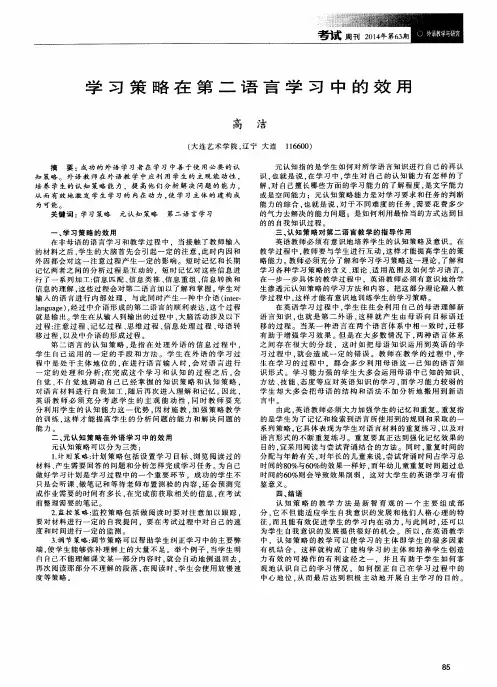
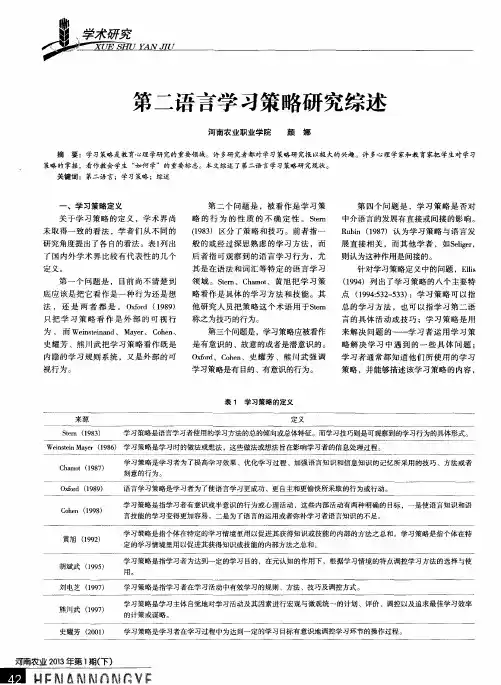
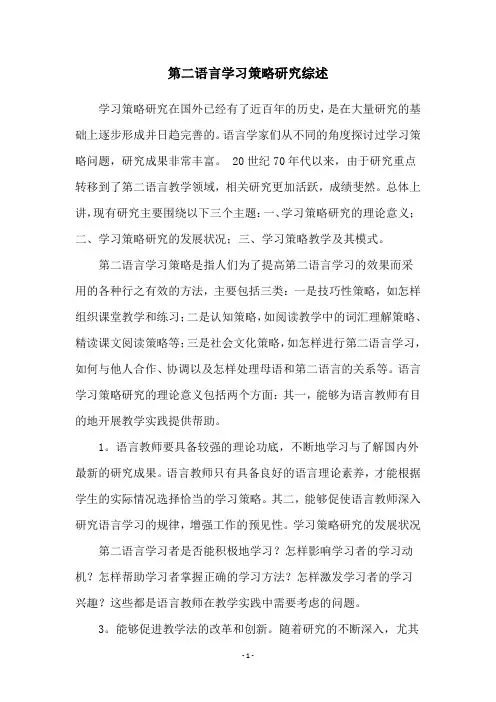
第二语言学习策略研究综述学习策略研究在国外已经有了近百年的历史,是在大量研究的基础上逐步形成并日趋完善的。
语言学家们从不同的角度探讨过学习策略问题,研究成果非常丰富。
20世纪70年代以来,由于研究重点转移到了第二语言教学领域,相关研究更加活跃,成绩斐然。
总体上讲,现有研究主要围绕以下三个主题:一、学习策略研究的理论意义;二、学习策略研究的发展状况;三、学习策略教学及其模式。
第二语言学习策略是指人们为了提高第二语言学习的效果而采用的各种行之有效的方法,主要包括三类:一是技巧性策略,如怎样组织课堂教学和练习;二是认知策略,如阅读教学中的词汇理解策略、精读课文阅读策略等;三是社会文化策略,如怎样进行第二语言学习,如何与他人合作、协调以及怎样处理母语和第二语言的关系等。
语言学习策略研究的理论意义包括两个方面:其一,能够为语言教师有目的地开展教学实践提供帮助。
1。
语言教师要具备较强的理论功底,不断地学习与了解国内外最新的研究成果。
语言教师只有具备良好的语言理论素养,才能根据学生的实际情况选择恰当的学习策略。
其二,能够促使语言教师深入研究语言学习的规律,增强工作的预见性。
学习策略研究的发展状况第二语言学习者是否能积极地学习?怎样影响学习者的学习动机?怎样帮助学习者掌握正确的学习方法?怎样激发学习者的学习兴趣?这些都是语言教师在教学实践中需要考虑的问题。
3。
能够促进教学法的改革和创新。
随着研究的不断深入,尤其是运用认知心理学、学习动力学、学习迁移、人类智力结构等理论所开展的研究,必将推动我国现有的外语教学理论得到发展和创新,促进第二语言教学理论水平的提高。
学习策略教学及其模式。
学习策略教学是指语言教师根据学生学习的特点,通过创设适宜的环境,利用各种手段与方法,使学生获得良好的学习策略,促进其语言学习的一种教学模式。
目前,国内外学习策略教学模式的研究大致分为四种类型:一是以国外的教学模式为代表,其中最为典型的是奥苏贝尔的“认知—情感”(又称“先行组织者”)教学模式。
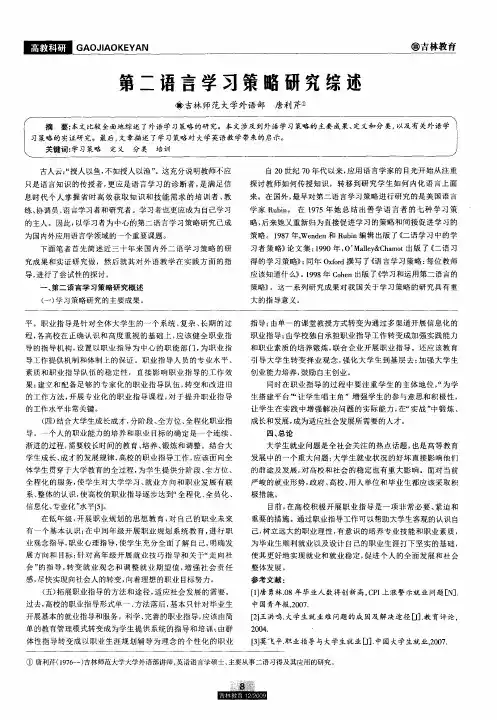
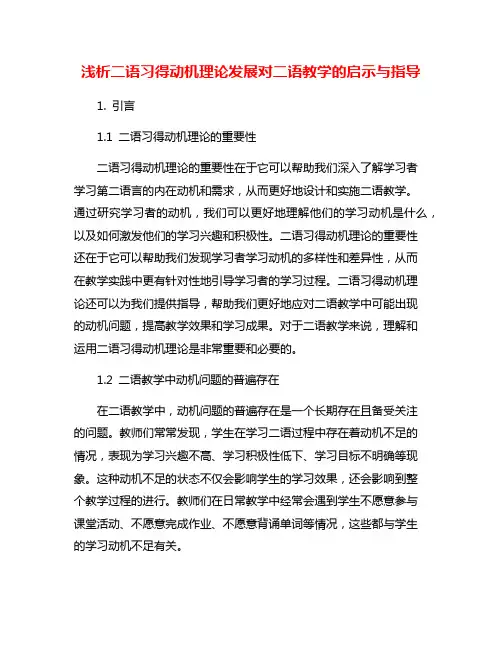
浅析二语习得动机理论发展对二语教学的启示与指导1. 引言1.1 二语习得动机理论的重要性二语习得动机理论的重要性在于它可以帮助我们深入了解学习者学习第二语言的内在动机和需求,从而更好地设计和实施二语教学。
通过研究学习者的动机,我们可以更好地理解他们的学习动机是什么,以及如何激发他们的学习兴趣和积极性。
二语习得动机理论的重要性还在于它可以帮助我们发现学习者学习动机的多样性和差异性,从而在教学实践中更有针对性地引导学习者的学习过程。
二语习得动机理论还可以为我们提供指导,帮助我们更好地应对二语教学中可能出现的动机问题,提高教学效果和学习成果。
对于二语教学来说,理解和运用二语习得动机理论是非常重要和必要的。
1.2 二语教学中动机问题的普遍存在在二语教学中,动机问题的普遍存在是一个长期存在且备受关注的问题。
教师们常常发现,学生在学习二语过程中存在着动机不足的情况,表现为学习兴趣不高、学习积极性低下、学习目标不明确等现象。
这种动机不足的状态不仅会影响学生的学习效果,还会影响到整个教学过程的进行。
教师们在日常教学中经常会遇到学生不愿意参与课堂活动、不愿意完成作业、不愿意背诵单词等情况,这些都与学生的学习动机不足有关。
在二语教学中,学生的学习动机问题普遍存在的原因可以是多方面的。
学习二语是一个长期的过程,学生往往需要花费大量时间和精力来学习,而这种长期的付出容易让学生产生疲倦和倦怠感。
学生学习二语时可能会遇到一些困难和挫折,这也会影响学生的学习积极性。
学生在学习过程中可能会感到缺乏自信心,觉得学习任务过于艰难,从而导致学习动机的下降。
二语教学中动机问题的普遍存在给教师们提出了挑战,教师们需要通过不断探索和实践,寻找有效的方法来激发学生的学习动机,提高学生的学习兴趣和积极性。
2. 正文2.1 二语习得动机理论的发展历程1. 初期阶段:主要集中在对学习者内在动机的探讨,如Gardner 对学习者的态度和情感因素的研究。
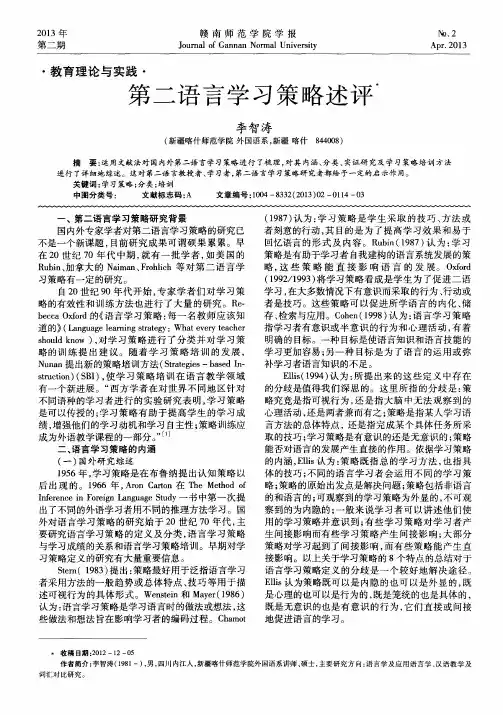
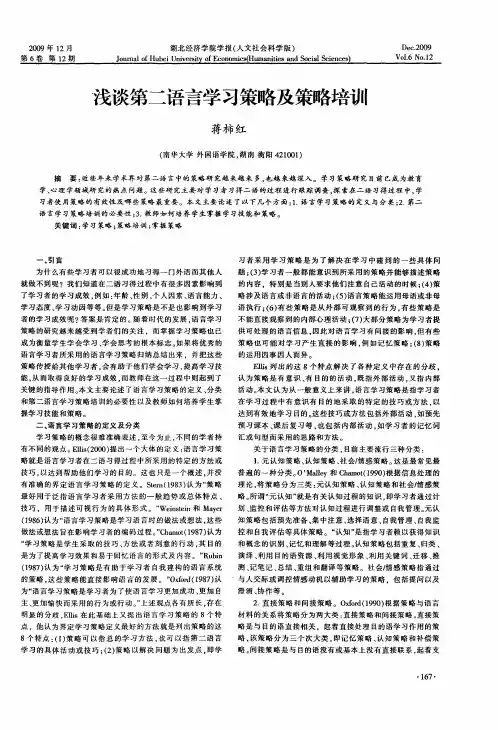

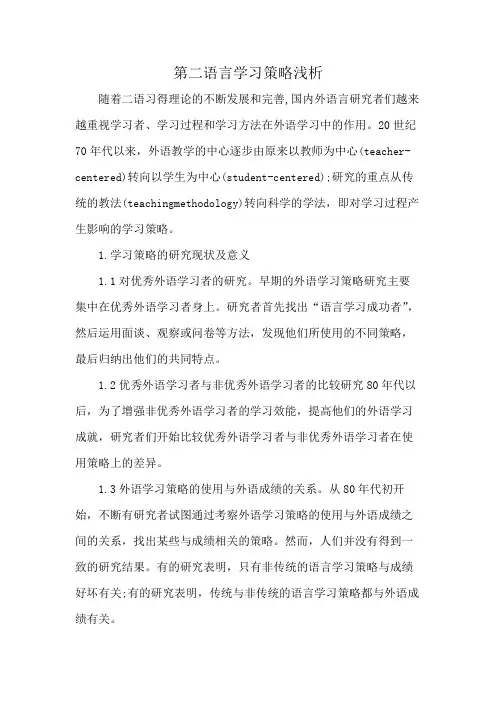
第二语言学习策略浅析随着二语习得理论的不断发展和完善,国内外语言研究者们越来越重视学习者、学习过程和学习方法在外语学习中的作用。
20世纪70年代以来,外语教学的中心逐步由原来以教师为中心(teacher-centered)转向以学生为中心(student-centered);研究的重点从传统的教法(teachingmethodology)转向科学的学法,即对学习过程产生影响的学习策略。
1.学习策略的研究现状及意义1.1对优秀外语学习者的研究。
早期的外语学习策略研究主要集中在优秀外语学习者身上。
研究者首先找出“语言学习成功者”,然后运用面谈、观察或问卷等方法,发现他们所使用的不同策略,最后归纳出他们的共同特点。
1.2优秀外语学习者与非优秀外语学习者的比较研究80年代以后,为了增强非优秀外语学习者的学习效能,提高他们的外语学习成就,研究者们开始比较优秀外语学习者与非优秀外语学习者在使用策略上的差异。
1.3外语学习策略的使用与外语成绩的关系。
从80年代初开始,不断有研究者试图通过考察外语学习策略的使用与外语成绩之间的关系,找出某些与成绩相关的策略。
然而,人们并没有得到一致的研究结果。
有的研究表明,只有非传统的语言学习策略与成绩好坏有关;有的研究表明,传统与非传统的语言学习策略都与外语成绩有关。
1.4影响外语学习策略使用的因素。
影响外语学习策略使用的因素有很多,归纳起来有两类。
一是因素与学习者本人有关,二是因素与语言学习环境有关。
前者统称为学习者因素,后者统称为环境因素。
1.4.1学习者因素。
学习者的个体差异如年龄、性别、学习者观念和外语语言水平等都会影响策略的使用。
学习者的外语语言水平不同,会影响学习者使用不同的策略。
学习者的生理和心理上的差异影响他们在外语学习中策略的选择。
学习者观念指学习者对如何学好外语的看法。
1.4.2环境因素。
外语学习策略的使用还受到环境因素的影响。
例如,学习者是在二语环境中,还是在外语环境中学习目标语言;教师使用的课堂教学方法是否不同;学习者期望获得听说读写的交际能力是否仅限于阅读;他们所要完成的学习任务与语言知识是否与交际能力相关等等。
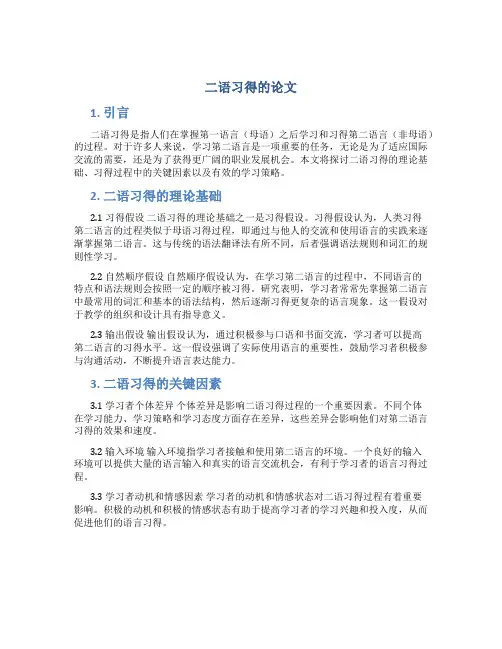
二语习得的论文1. 引言二语习得是指人们在掌握第一语言(母语)之后学习和习得第二语言(非母语)的过程。
对于许多人来说,学习第二语言是一项重要的任务,无论是为了适应国际交流的需要,还是为了获得更广阔的职业发展机会。
本文将探讨二语习得的理论基础、习得过程中的关键因素以及有效的学习策略。
2. 二语习得的理论基础2.1 习得假设二语习得的理论基础之一是习得假设。
习得假设认为,人类习得第二语言的过程类似于母语习得过程,即通过与他人的交流和使用语言的实践来逐渐掌握第二语言。
这与传统的语法翻译法有所不同,后者强调语法规则和词汇的规则性学习。
2.2 自然顺序假设自然顺序假设认为,在学习第二语言的过程中,不同语言的特点和语法规则会按照一定的顺序被习得。
研究表明,学习者常常先掌握第二语言中最常用的词汇和基本的语法结构,然后逐渐习得更复杂的语言现象。
这一假设对于教学的组织和设计具有指导意义。
2.3 输出假设输出假设认为,通过积极参与口语和书面交流,学习者可以提高第二语言的习得水平。
这一假设强调了实际使用语言的重要性,鼓励学习者积极参与沟通活动,不断提升语言表达能力。
3. 二语习得的关键因素3.1 学习者个体差异个体差异是影响二语习得过程的一个重要因素。
不同个体在学习能力、学习策略和学习态度方面存在差异,这些差异会影响他们对第二语言习得的效果和速度。
3.2 输入环境输入环境指学习者接触和使用第二语言的环境。
一个良好的输入环境可以提供大量的语言输入和真实的语言交流机会,有利于学习者的语言习得过程。
3.3 学习者动机和情感因素学习者的动机和情感状态对二语习得过程有着重要影响。
积极的动机和积极的情感状态有助于提高学习者的学习兴趣和投入度,从而促进他们的语言习得。
4. 有效的学习策略4.1 意识化学习策略意识化学习策略是指通过有意识地关注语言的形式和结构,来提高语言习得效果的策略。
学习者可以通过分析语言现象、记忆规则和词汇等方式,加深对语言的理解和掌握。
第二语言教学的策略与方法在当今全球化的时代,学习第二语言已经成为一种必备的技能。
但是很多人却往往遇到学习第二语言的难题。
针对这个问题,第二语言教学策略和方法越来越受到人们的关注。
在本文中,我将探讨几种常见的第二语言教学策略和方法。
1. 沉浸式学习法沉浸式学习法是将学习者完全投入到第二语言的学习环境中,让他们通过日常生活和学习获得第二语言,而不是通过翻译、语法规则、单词列表等传统方式。
这种方法相对于传统的语法翻译法更为有效,因为它更加注重语言应用和语言交际技能的培养。
此外,学习者可以逐渐熟悉第二语言的音韵、语调、语感、语境等,从而更自然地将其融入到日常生活中。
2. 以交际为中心的教学法以交际为中心的教学法是注重学习者在实际交际中运用目标语言的技能的方法。
它更注重对学习者交际能力的提高,适应于需要用第二语言进行日常生活和工作的学习者。
这种方法的关键是实践,这意味着学习者需要不断地与其他母语为目标语的人进行交流,以获得更多得实践经验。
3. 固定句型教学法固定句型教学法是针对学习者在口语表达能力方面存在的问题而开发的教学方法。
它采用一些常见的固定句型和搭配,并以口语为重点进行教学。
通过教学,学习者将能够更加流畅地进行口语交流,更有效地回答问题,更轻松地表达自己的意见。
4. 任务型教学法任务型教学法是一种注重学习者主动探究的教学方法。
在这种方法中,学习者被赋予一项任务,并需要在完成任务的过程中学习和应用目标语言。
它的重点是培养学习者的自主学习能力和实践能力,让学习者在实际应用中更有效地掌握目标语言。
无论是以上哪一种教学方法,学习者都需要面对困难和挑战。
学习第二语言需要长期的坚持和努力,因此教师在教学过程中需要给予学习者充分的支持和鼓励。
只有通过长期的学习和实践,学习者才能真正地掌握目标语言。
总之,教学方法的选择需要考虑到学生的个体差异和学习目标。
不同的人需要不同的教育方法。
教师在进行教学时需要灵活运用多种教学方法,以满足不同学习者的需求,让学习者真正掌握第二语言。
广告书评认知与情感是影响语言学习的两大重要因素,学习者个体的认知、心理情感因素已成为二语习得领域的重点研究问题。
动机作为维持语言学习者学习热情的重要情感因素,是激发二语学习的重要源动力与驱动力,也是决定二语学习成败与否的关键性因素之一。
只有具有较强的学习动机,学习者才能更持久地进行语言学习,取得更有效的学习效果,然而动机衰退也是二语学习者在漫长的语言学习过程中不容忽视的问题之一。
因此,二语教师在教学中如何改变教学思路,利用有效动机策略与手段,激发并增强学习者的二语动机,是二语教学及研究者亟须思考的重要问题。
由徐智鑫、张黎黎著的《二语动机:理论综述与案例分析》一书,便是基于理论视角及案例分析层面对二语学习动机及二语动机教学策略研究的有益探索。
笔者在全国教育科学规划教育部青年课题“基于认知视角的工科院校留学生汉语学习动机与学习策略相关性研究”(编号:EIA160466)研究过程中,对本书作了重点研读。
二语动机有两个明显的特征:一是复杂性,动机是一个复杂、多维的概念,受多方面因素的支配和制约;二是动态性,会随着时间的变化和情境的多变而呈现高低起伏的状态。
因此,要把关于二语学习动机与二语动机教学策略的理论应用到实践中去,必须将它们放在特定的社会文化教育情境中,以便进行全面的、动态的、应用性的综合研究。
该书围绕第二语言动机研究中最为重要的两个概念,即二语学习动机与二语动机教学策略展开,着力体现二者的复杂性和动态性。
该书包括理论综述与案例分析两个部分,理论部分分别从心理学和应用语言学视角论述了不同的学术观点和研究成果,从理论上阐明了不同动机因素之间的关系,为相关研究提供了较为完善的理论基础。
案例分析部分则详细介绍并分析了与二语学习动机和二语动机教学策略研究相关的研究范式、研究类型、研究方法,体现了宏观的认识论和方法论。
该书注重理论与实践相结合,就二语动机的“教”与“学”进行了理论探讨与实践研究。
从理论角度而言,该书理论阐述比较全面、系统,学术观点比较科学、可信。